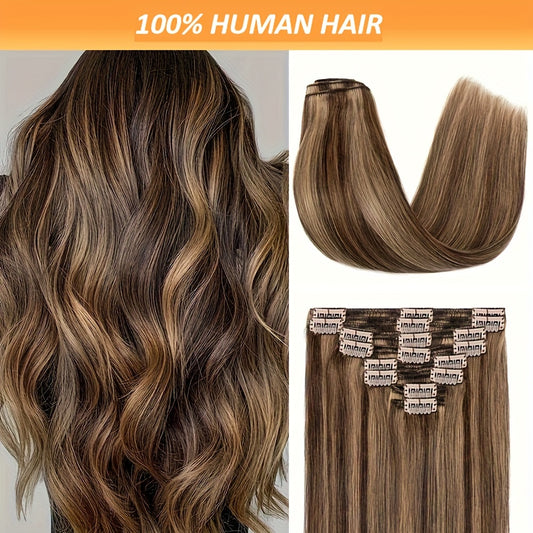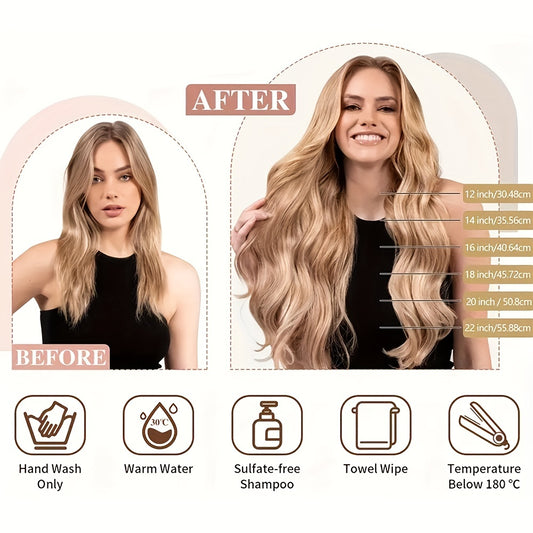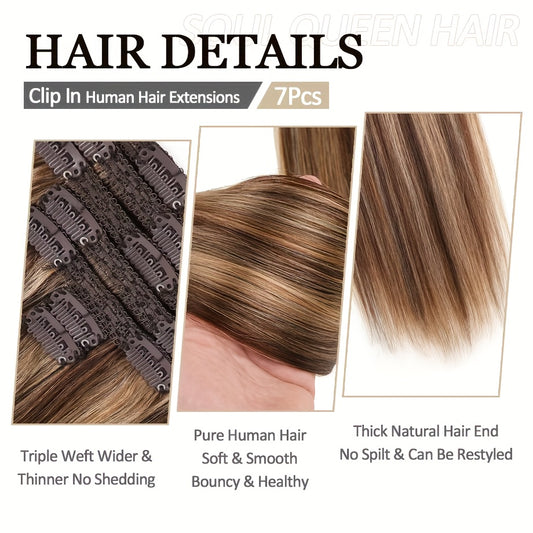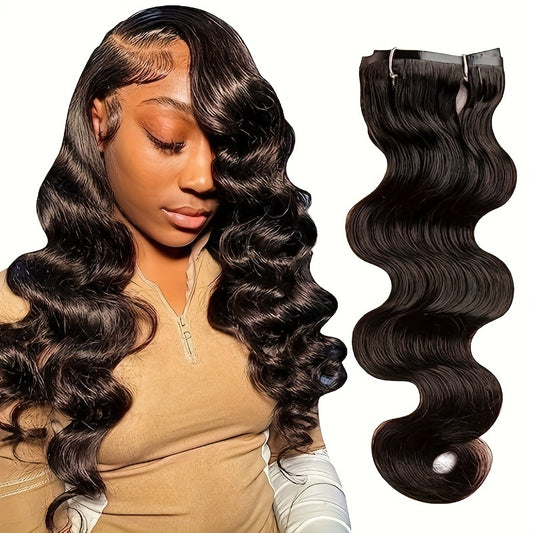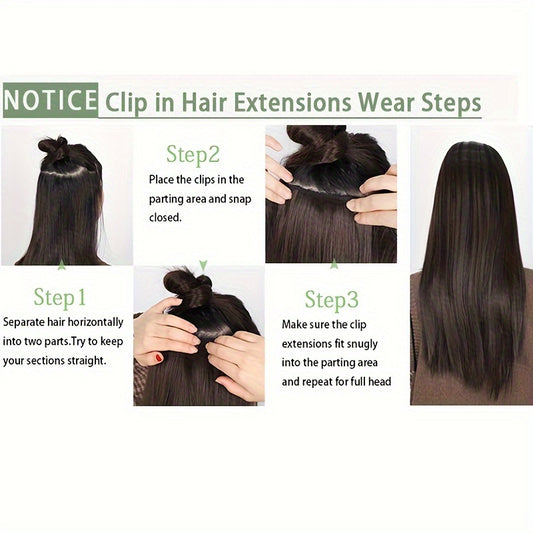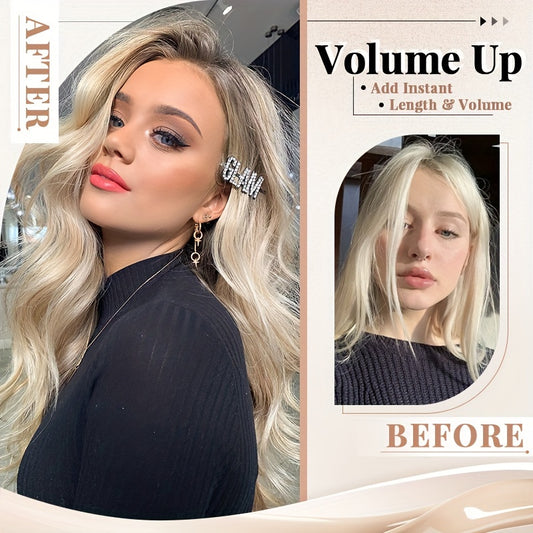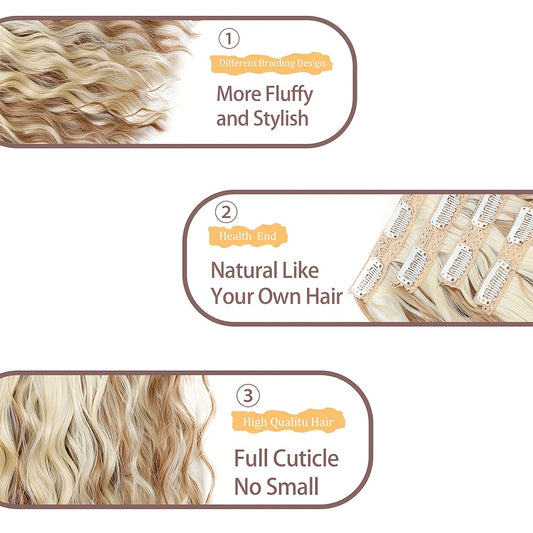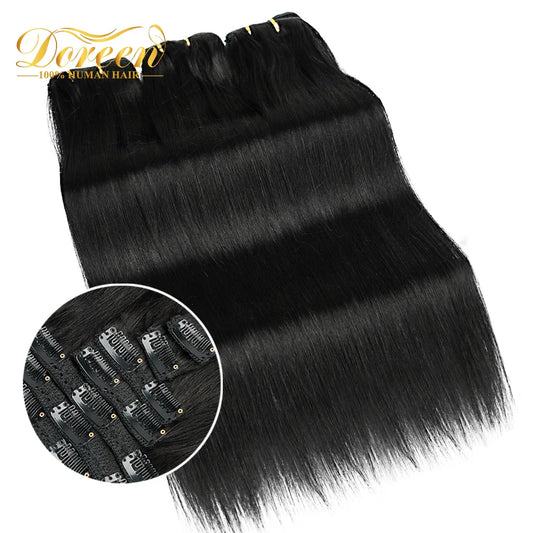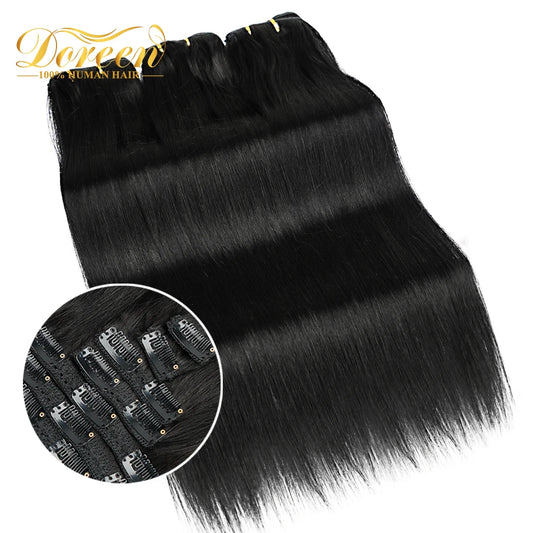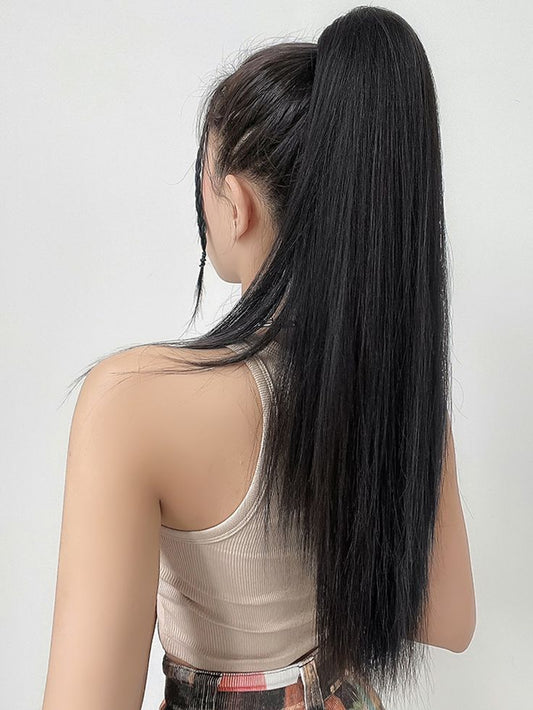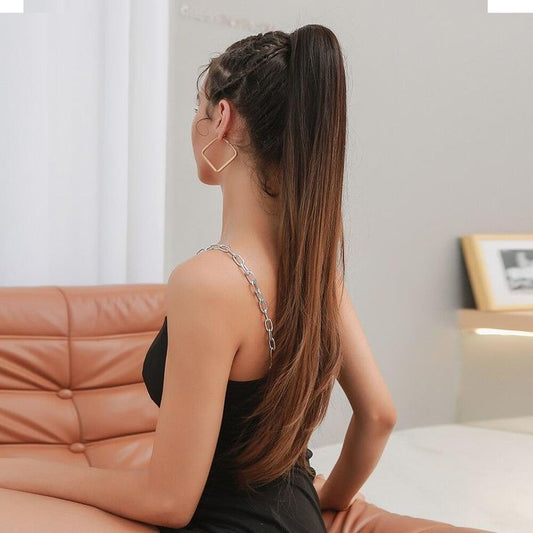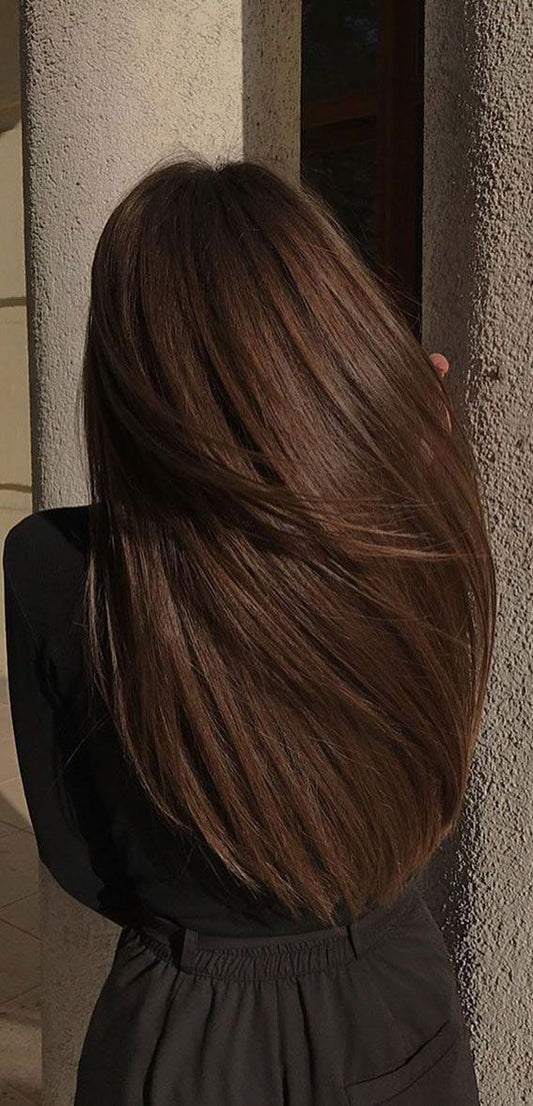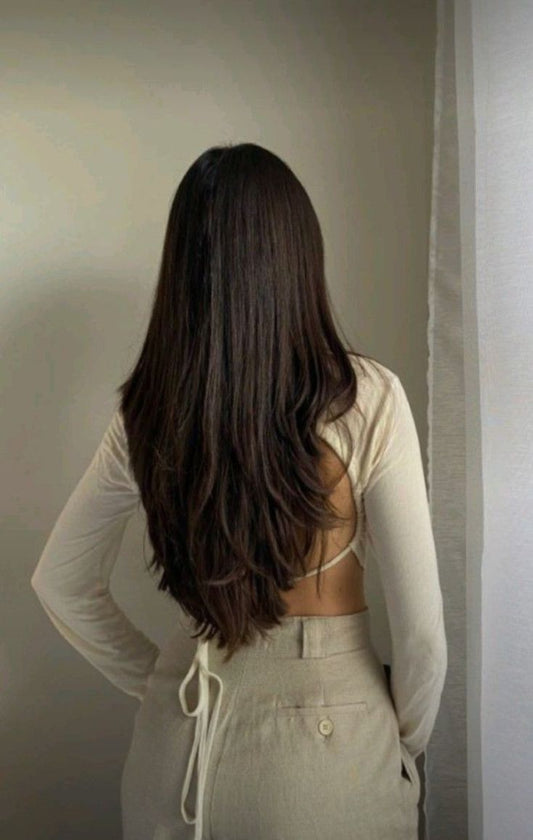About 16 Inch Clip In Hair Extensions
Who this length serves best?
Wearers with natural hair at or near the shoulder obtain a visible length increase and a wider perimeter, allowing blowouts and curl sets to hold shape until evening. Fine and medium strands benefit most because added mass stabilizes the mid-lengths. On camera, sixteen inches reads undeniably long without the tangling and zipper friction associated with twenty-inch sets. Brides, educators, streamers, consultants, and frequent travelers converge here because styling time remains low while the visual payoff is high. The length also retains compatibility with low buns, claw-clip twists, and half-ups, which protects the illusion during events and layered wardrobes.
Body placement and proportion
Sixteen inches typically lands at mid-chest for average height in straight finishes, rests slightly higher on petite frames, and sits a touch lower on tall frames with shorter necks. Waves shorten the visual by roughly one inch; tighter curls compress further, so habitual curl wearers may prefer either denser ends for a confident perimeter or a placement strategy that sets the bottom line slightly lower. The proportion supports blazers, V-necks, square necklines, and high collars when brushed smooth; the hem clears most scarf lines to reduce friction at the nape. The visual field that cameras evaluate—the bottom third—remains present and deliberate at this length.
Grams selection for density
Weight establishes authority at the hem. Ninety to one hundred twenty grams yields subtle fullness and stronger ends for layered cuts or fine hair that collapses quickly. One hundred thirty to one hundred sixty grams achieves an everyday full head that photographs dense yet feels light on the scalp. One hundred seventy to two hundred twenty grams maintains a plush hem for blunt cuts, thicker natural strands, or climates and lighting where styles must endure. Buyers with one-length bobs often underestimate grams; without adequate mass, the transition line between natural hair and extension hair forms a shelf that cameras exaggerate.
A selector that maps grams to haircut archetypes reduces returns. Examples: blunt lob at the shoulders equals one hundred eighty grams recommended; layered shoulder-length equals one hundred forty grams baseline; thick, tapered natural hair equals one hundred sixty to one hundred ninety grams; fine mid-lengths equals one hundred twenty to one hundred forty grams plus optional temple boosters for balance. Naming the install feel—light, medium, plush—helps quantify comfort alongside volume.
Draw and end behavior
Single-drawn hair presents a gentle taper that mimics natural shedding patterns; it brushes into movement and reads soft. Double-drawn hair retains density into the lower third, generating a crisp, fresh-cut perimeter that looks premium in straight or beveled finishes. At sixteen inches, the hemline is an inspection point for cameras; therefore, the page should show a cropped back-of-head image of the ends at rest. If only one draw variant is in stock, describe the end feel plainly and recommend a half-inch micro-trim by a stylist when a denser square is desired without escalating to a higher grams tier.
Texture mapping for blending
Straight texture delivers glass-hair geometry and linear shine. Body wave is the universal blender that tolerates single-pass smoothing or expands into plush curves; it reduces heat exposure because the set retains shape after cooling. Curly and coily textures must be chosen by coil diameter rather than general labels to avoid mismatched stacking. A small swatch grid or diameter chart reduces selection errors. Sixteen inches favors body wave for many users because a modest bend lifts the hem visually, maintains proportion, and limits styling time.
Shade and undertone clarity
Undertone first, depth second. Buyers should verify color in daylight near a window; indoor bulbs distort balance. If between two shades, slightly lighter is safer because Remy human hair accepts toners that cool or darken, whereas lifting degrades cuticles. Rooted and balayage options erase seams at the part and temple, especially with darker roots. A one-line prompt to take a daylight photo for personal reference helps during reorders and stabilizes expectations across seasonal lighting shifts.
Why remy human hair matters
Aligned cuticles keep friction low, tangling predictable, and sheen natural rather than glassy. Remy fibers respond well to moderate heat: one slow pass straightens efficiently, and low-heat curling holds once cooled. Gentle washing preserves the cuticle; demi toners adjust undertone incrementally. Over months of use, these traits maintain end integrity at sixteen inches where the hem is always in the frame. The practical effect is fewer corrective passes, less time spent detangling, and a perimeter that remains convincing beyond the first dozen wears.
Clip-in method overview
Clip-ins provide on-demand length and density with no salon move-ups. The base map places the widest weft at the nape for anchor stability, medium wefts around the occipital curve for body, and narrow wefts at the sides to fill temples and contour the face frame. Minimal root teasing and a mist of flexible spray create reliable anchor points. A generous crown layer remains unwefted to cover hardware in motion. Sensitive scalps can limit daily piece count and reserve two side boosters for events.
Placement flow and blending behaviors
Detangle both natural hair and wefts. Create a horizontal section above the nape and clip the remainder upward. Tease minimally where clips will sit. Anchor the middle clip of the widest weft first, then its sides. Move upward by roughly one inch per row, placing the next widest weft and then mediums as the head curves. Finish with narrow wefts at the sides to strengthen temples. Keep the top layer ample. For waves, alternate curl directions in the back and curl away from the face in front; cool completely before brushing into a single pattern. For straight, apply heat protectant and cap tools at one hundred eighty Celsius or three hundred fifty Fahrenheit; one slow pass beats multiple fast passes.
Style catalog suited to 16 inches
Center-part blowout with beveled ends for an executive outline. Deep side part that produces crown lift and asymmetry on demand. One-and-a-quarter-inch barrel waves cooled and brushed into a continuous, plush shape. Minimalist pinned-back sides that expose earrings while keeping the silhouette intact. Two narrow temple braids to add controlled texture without clutter. Compact claw-clip French twist that clears collars and sits securely through movement. Sleek low pony at the nape with a combed surface and a micro-drop of serum on mid-lengths and ends. Uniform curls brushed into a wave sheet and sealed by misting flexible spray onto the brush rather than directly onto hair.
Care cadence and storage
Brush before and after wear using a loop brush or wide-tooth comb while supporting wefts with the other hand. Wash every ten to fifteen wears or when product buildup appears. Shampoo the scalp and let suds pass through lengths; condition from mid-lengths to ends; rinse cool to close cuticles; blot with microfiber; air-dry on a hanger. Maintain heat discipline with protectant and single deliberate passes. Store brushed wefts coiled in a gentle U inside a satin pouch away from heat and humidity. Rotate clip locations slightly day to day to avoid repeated pressure on the same follicles.
Troubleshooting protocol
Weft visibility under bright lights or wind indicates insufficient coverage or placement height; shift the part a few millimeters or add a slim cover weft one section higher. Wispy ends suggest either a micro-trim of half an inch to one inch or selection of double-drawn in a future order. Nape tangles under scarves or collars require end hydration, reduced heat for several days, and brushing after outerwear removal. Clip slippage on fine hair is mitigated by cleaning clip teeth, using a light texture spray at the roots, and avoiding freshly conditioned zones. Close-but-not-exact color can be harmonized with a cool or neutral demi toner; rooted or balayage variants hide small mismatches. Scalp tenderness calls for placement variation and rest days.
Workout and travel practices
Remove clip-ins before high-intensity exercise to prevent root strain and friction. For light sessions, a low braid with a soft headband minimizes movement; brush only once hair is cool and dry. Pre-flight, smooth a small amount of serum through ends and store in satin; post-landing, refresh with a leave-in mist and a quick brush. For destination events, set curls, allow complete cooling, brush to unify, and set by misting flexible spray onto a brush for controlled hold. Keep a mini brush and spare clips in the pouch as field tools.
Quality signals and sourcing expectations
A credible collection explains material and process: one hundred percent Remy human hair with aligned cuticles, secure stitching with consistent density per centimeter, transparent sourcing with fair compensation, minimal chemical processing to preserve fiber strength, and batch testing for clip tension and shed resistance. Daylight shade charts, grams calculators, and install videos reduce misuse and returns. A no heavy silicone masking statement signals honesty; a clear aftercare guide closes the loop between purchase and longevity.
Conversion notes for the page
Concise copy near the top should resolve body landing point, grams for common scenarios, heat policy, and wash cadence. A color-assist microflow that asks for undertone first or a daylight photo reduces uncertainty. A direct time claim—five minutes from case to camera-ready for experienced users—creates concrete expectations. Place shipping and returns within one click of the add-to-cart button to handle late-stage hesitation. Place a single-sentence undertone tip beside color swatches to prevent mismatches before they occur.
Measurement guidance buyers use
Advise measuring from behind the ear to mid-chest to simulate sixteen inches in a straight finish. Suggest evaluating with favorite necklines to gauge proportion. Note that waves reduce apparent length by roughly one inch. Encourage a daylight reference photo for color benchmarking and a small curl test to determine whether daily styling compresses enough to justify a denser hem or a slightly adjusted placement.
Comfort and safety reminders
Clips should anchor without pinching. If discomfort occurs, re-tease lightly or reposition the weft. Do not sleep in clip-ins. Keep heavy oils and balms away from roots to preserve grip, especially on fine hair. For sensitive scalps, reduce daily piece count and add side boosters only for events. Rotate precise clip positions to distribute load and protect follicles. These constraints are practical, not restrictive; they sustain both realism and comfort across months of wear.
Ownership mindset
Treat the set as a wardrobe component with a care routine. Brush, store, and heat-protect intentionally. Plan a seasonal micro-trim if ends feel airy after repeated brush-outs. Track shade code, grams, tool temperature, and product list so a reorder reproduces success. Capture a daylight photo after a perfect install; that reference stabilizes perception through different rooms and seasons. Consistency is where longevity lives.
Adjacent length comparison
Versus fifteen inches, sixteen adds a clearer impression of long hair in straight finishes with minimal additional upkeep. Versus eighteen inches, sixteen reduces friction around zippers and straps, accelerates styling by requiring fewer passes, and keeps the hem easier to square without aggressive heat. For many buyers seeking a daily driver that reads long in photos, sixteen is the balance point between presence and practicality.
Use cases by lifestyle
Corporate day: center-part blowout that stays neat from commute through meetings. Creator workload: reliable end density that photographs clean under mixed lighting with fast resets. Wedding itinerary: sculpted waves for ceremony, low bun for reception, both supported by sixteen-inch perimeter. Travel routine: compact storage, low tangle risk around bags, quick post-flight refresh. Fitness schedule: remove for high intensity; reinstall in minutes for dinner—no compromise to scalp comfort.
Micro-tips that compound results
Use a fine-tooth teasing comb to create precise anchors without bulky knots. Aim dryer airflow downward to align cuticles and reduce frizz. Spray flexible hold onto the brush, not directly onto hair, before the final sweep to keep sheen. Keep two ultra-narrow wefts dedicated to temple balancing to adapt to earrings and part shifts. For crown lift without teasing, over-direct forward during blowout and let sections cool in place before laying back.
Operational faq for support teams
Shelf line visible on blunt bobs: recommend higher grams, place a slim cover weft above the transition, and style natural hair together with extensions. Warm match indoors despite a good outdoor match: verify daylight first and, if needed, apply a cool demi toner; emphasize that slightly lighter is easier to correct. Clip slippage on fine hair: suggest light texture spray, minimal teasing, and checking silicone sleeves on clip teeth. Nape tangling: review scarf friction, heat frequency, and brushing cadence; prescribe end hydration and a temporary heat holiday.
Photography guidance
Shoot in daylight at approximately 5600K to keep white balance neutral. Provide front, side, back, and a cropped end view for each shade. Photograph each color on at least two skin tones and include a strand-on-white swatch to neutralize background influence. Present both straight and waved examples for the same shade to demonstrate behavior under styling. Avoid saturation boosts that misrepresent undertone; accuracy lowers returns and raises review credibility.
Accessibility considerations
Support color names with numeric descriptors such as level 6 neutral brown for colorblind users. Add alt text that references length, texture, and undertone, not just poetic shade names. Ensure the grams selector is keyboard accessible and announces changes to screen readers. Maintain adequate contrast for on-image labels and avoid ultra-light gray text. Provide text-only install steps and captions for any placement videos so all buyers can internalize the process.
Environmental and seasonal care
Cold, dry months elevate static; increase leave-in hydration, reduce heat, and use silk pillowcases for natural hair. Hot, humid months expand texture; lean into body wave, favor flexible sprays over heavy creams, and reduce oils at the roots. Windy conditions require secure placement, smaller cover wefts at higher rows, and an ear tuck plan for sudden gusts. For climate shifts during travel, carry a compact kit—loop brush, satin pouch, travel serum, and flexible spray—and adjust product load on arrival.
Material science primer
Cuticle scales overlap in one direction; when aligned, fibers glide with less interlocking. Heat softens hydrogen bonds in the cortex and allows reconfiguration; as hair cools, bonds reset in the new pattern, which is why complete cooling before brushing is an explicit rule. Excess heat fractures cuticle plates and invites roughness; silicone films can mask damage temporarily but impede moisture exchange and create glare. Remy sourcing preserves directionality; non-Remy often relies on acid processing and heavy silicone to simulate smoothness, which declines after washes and shortens usable life.
Comparative economics
Cost-per-wear favors clip-ins for users alternating between down styles and hair-up days. Because the set rests between uses, fiber fatigue accumulates more slowly than in semi-permanent methods. A maintained Remy set can serve for months; amortized across dozens of outings, the per-wear cost undercuts many single-appointment services. Time economics also matter: a five-minute install replaces booking, traveling, and waiting for a styling slot. For brands, clarity about shade selection and grams mapping reduces avoidable returns, preserving margin while lowering support volume.
Common myths debunked
Myth: more grams is always better. Reality: density must match haircut and head size; excess mass near the crown invites exposure and discomfort. Myth: high heat is necessary for curl memory. Reality: moderate heat paired with complete cooling yields durable results and protects cuticles. Myth: rooted colors are just aesthetic. Reality: subtle root shadows function as blending tools that erase seams at parts and temples. Myth: clip-ins cannot be worn under hats. Reality: at sixteen inches, lower placements and ear tucks keep coverage intact under most brims.
Vendor vetting checklist
Confirm cuticle alignment and post-wefting grams measurement. Request daylight photos of each shade on two complexions plus end crops. Verify stitching density and thread specification. Confirm return policy for unopened hair and availability of spare clips. Ask about batch tests for clip tension and shed resistance. Traceability across batch IDs supports consistent quality and quick issue resolution.
Legal and returns notes
Hygiene seals and tamper-evident packaging protect both buyer and seller. Returns should require hair to be unworn, unstyled, and in the original net and pouch. Processing timeline and responsibility for return shipping must be stated clearly. Toned or altered items should be ineligible for return; therefore the page emphasizes daylight checks before any treatment. Clear policies reduce disputes and set expectations that align with hygiene realities.
Localization considerations
Represent diverse complexions and textures in photography so international buyers recognize themselves in the catalog. Use shade names that translate cleanly, and supply both metric and imperial units. Provide region-specific shipping estimates and set expectations for customs. Maintain at least one support channel that responds across time zones, with stated response-time targets. Localization is operational, not decorative; it shortens the path from curiosity to purchase worldwide.
Edge cases and constraints
Very short natural hair above the jawline may not conceal hardware; recommend waiting for more growth or using a halo until coverage improves. Extremely dense natural hair may require custom grams or a professional sew-in for credible straight finishes. Medical or dermatological sensitivities warrant cautious testing and possibly consultation prior to wear. High ponytail preference is not aligned with standard clip-in maps; low buns and down styles are the optimized scenarios for concealment and comfort.
Ux microcopy examples
Color tip: check in daylight; choose undertone first. Grams guide: match density to your haircut. Install: section, anchor, blend—three steps, five minutes. Heat: keep tools under 180°C/350°F. Care: brush, coil, store in satin. Returns: try on gently; tone only after you love the match. Each sentence is utilitarian and decision-oriented, reinforcing analysis rather than lifestyle framing.
Metrics to monitor
Track click-through rate on length-specific queries, filter engagement for grams and shade, dwell time on shade charts, add-to-cart rate after opening the install primer, color-related return rate, and support topics by category. Rising color-related returns imply lighting or naming issues; rising comfort concerns imply gaps in grams mapping or placement guidance. Treat each metric as a feedback loop that rewrites microcopy and refines media rather than as a static report.
A/b test ideas
Compare hero copy that states body placement versus a benefit-led variant; measure scroll depth and bounce rate. Evaluate grams-by-cut tiles against a simple dropdown; measure time-to-cart. Default to rooted shade imagery versus flat shade imagery; measure color-related returns. Move the install diagram above versus below reviews; watch conversion change. Isolate one variable per test and run long enough to overcome noise and weekly pattern shifts.
Post-purchase onboarding
Day zero email links to the three-step install and care cadence. Day three reinforces cooling-before-brushing and heat limits. Day ten invites a daylight photo for color benchmarking and offers toner guidance for undertone tuning. Day thirty suggests a micro-trim for a denser edge and requests a review with name, city, and country to support future buyers. This cadence front-loads useful behaviors and captures social proof without coaching buyers into long prose.
Care timeline calendar
Weeks one to four: gentle wear, consistent brushing, minimal heat. Weeks five to eight: reassess grams against current haircut, adjust placement for comfort, clean clip teeth. Weeks nine to twelve: deeper wash cycle, extended air-dry, micro-trim if ends feel airy. The rhythm prevents neglect that leads to preventable issues; small, regular actions extend lifespan more than occasional overhauls.
Sustainability notes
Longevity reduces waste; thus clear care guidance is both customer-friendly and environmentally pragmatic. Packaging should be compact, protective, and recyclable where possible. Providing spare clips and a simple repair guide extends service life. Transparent sourcing and processing statements replace slogans with specifics that can be verified by informed buyers.
Advanced blending by haircut
Blunt lob with zero layers needs strategic mass and height: place a medium-width cover weft one section higher than the blunt edge to dissolve the shelf, then curl natural and extension hair together in alternating directions at the back. Heavy face-frame layers benefit from two narrow temple pieces trimmed on a shallow diagonal to echo the framing line and prevent hollowness above the cheekbone. V or U hems align best when the extension perimeter matches the lowest natural point and receives a half-inch micro-trim to unify the outline.
For shag or wolf cuts with high layers, reduce back density and concentrate on side fill to respect the silhouette. One-length bobs often warrant double-drawn ends or a higher grams tier to mimic a crisp, salon-straight edge at sixteen inches. These adaptations work at the decision point where authenticity is judged: the edge and how it meets light.
Color maintenance timeline
Month one confirms undertone accuracy in daylight; tone only if needed and record the product and timing. Month two accounts for seasonal light changes; LEDs and skylight shift perception and may require a cooler glaze. Month three revisits root depth after natural regrowth; a rooted extension can bridge contrasts without repainting. Month four and beyond applies toner only when photos reveal mismatch—unnecessary chemistry shortens lifespan while offering no visual win.
Heat tools and diameters
Flat irons: a single, deliberate pass under one hundred eighty Celsius achieves polish on Remy fibers. Curling irons: one-and-a-quarter inch barrels brush into editorial waves at this length; one inch barrels yield tighter textures that expand after brushing. Hot rollers: medium sizes placed horizontally through the mid-lengths add body without over-curving the ends; full cooling is mandatory. Round brushes in the thirty-five to forty-five millimeter range produce beveled ends without forcing high heat. Tool choice should follow the camera distance and lighting rather than habit.
Troubleshooting color issues
Warm glow under indoor bulbs despite a daylight match implies environment bias; apply a brief cool glaze rather than a level shift. Green cast from pool exposure calls for gentle clarification and a neutralizing mask; avoid harsh chelators that strip cuticle. Flatness in photos with accurate undertone suggests even depth; introduce a subtle root shadow to add dimension and hide part seams. Dark banding near ends often traces to product accumulation; reset with a deep cleanse and move to lighter serums.
End-user preflight checklist
Verify shade in daylight and photograph the result. Select grams based on haircut archetype. Inspect clip springs and silicone sleeves. Clean hot tools and set temperature limits. Organize loop brush, teasing comb, and flexible spray. Perform a dry-run install on a quiet evening. Pack the satin pouch for gym or travel removal. Consider booking a micro-trim appointment after initial wears if a denser edge is preferred.
Retail operations notes
Include a mini care card with heat limits, wash cadence, and storage steps; add a QR to a short install video. Standardize grams and draw terms across SKUs to stabilize filters. Track return reasons and feed patterns into microcopy changes. Rotate review highlights with name and location to build global proof. Offer a low-cost clip replacement kit to extend product life and deter full-set returns for minor hardware issues.
Quality assurance checklist
Inspect stitching density per centimeter and edge finishing for stray fibers. Test clip recoil from each batch. Confirm grams measured post-wefting. Photograph shades in daylight against neutral backdrops and on two skin tones. Water-test a sample weft for colorfastness. Link batch IDs to shipments for traceability so any anomaly can be isolated and remediated without affecting all inventory.
Clip engineering details
Spring steel alloys with memory preserve tension through repeated cycles. Corrosion-resistant coatings protect against perspiration and ambient humidity. Teeth must align to grip without gouging; silicone sleeves should be uniform and replaceable. Aperture geometry balances hair capture versus snag risk; hinges must close smoothly without stressing the stitching. Minute tolerances here present as comfort differences during all-day wear—and buyers notice.
Weft layouts and widths
An effective set pairs a broad nape anchor, two medium occipital wefts for structure, and multiple narrow side wefts for precise temple and face-frame control. Wide pieces reduce seam count but need flatter head curves; narrow pieces increase adaptability in complex zones. Sixteen-inch sets often benefit from one extra narrow piece per side to sustain balance as parts shift throughout the day. Labeling widths inside the pouch accelerates morning placement and reduces guesswork.
Root volume without teasing
Over-direct sections forward during blowout, cool fully, then lay back to create lift without backcombing. Use lightweight root mists sparingly; residue near clips reduces grip. Small part shifts by millimeters refresh coverage without adding more pieces. Place a medium weft one section lower than instinct so the natural top layer provides final lift without exposing hardware.
Photo and video capture settings
Use daylight-balanced lighting near 5600K. Lock focus and exposure on the hair when demonstrating color; faces mislead auto-exposure. Frame the hemline and part line early in the clip; proof precedes narrative. Avoid saturation and white-balance edits that alter undertone; accuracy earns fewer color-related returns and raises the credibility of reviews.
Education snippets for customers
Cooling sets shape; brushing while warm erases memory. Undertone is the decision, depth is the refinement. One slow pass produces more polish and less damage than several quick zips. Window light tells the truth about shade. Rotate placement to protect roots. These lines function as compact rules that improve outcomes without requiring long guides.
Case study one
A consultant with a collarbone blunt cut selected one hundred thirty grams and saw a shelf line on camera. Upgrading to one hundred eighty grams, adding a cover weft above the transition, and performing a half-inch micro-trim produced a continuous edge. Time-to-style decreased because corrective passes ended. The grams-by-cut mapping translated directly to a measurable result: fewer reshoots and higher confidence in photos.
Case study two
An online coach in a humid region used high heat daily and reported rough ends after four weeks. Switching to lower heat with pin-cooling and brushing only after full cooling restored surface feel and increased curl longevity. Heat cycles dropped by half, and the set’s usable lifespan extended; the change validated the temperature cap and cooling rule as practical longevity levers.
Edge hairstyles and limitations
Standard clip-in mapping prioritizes down styles, half-ups, low ponies, and claw-clip twists. High ponytails and top knots expose hardware unless advanced mapping is used, which increases complexity. If frequent high ponytails are non-negotiable, a halo or professional method with different anchor mechanics is more suitable. Clear boundaries align expectations with what physics allows.
Return prevention tactics
Place an undertone explainer adjacent to color swatches. Display daylight photos on two models plus a strand-on-white for each shade. Present the grams-by-cut selector above the add-to-cart button. Keep the three-step install primer within one scroll of the hero. Introduce a pre-check reminder to try on gently and to hold toning until the match is loved. These steps are light touches that prevent avoidable disappointment.
Buying journey microcopy
Where it lands: mid-chest on most. How it feels: light daily, plush for events. Install: section, anchor, blend—five minutes. Heat: under 180°C/350°F. Care: brush, coil, satin store. Color: undertone first, then depth. These lines act as signposts that assist decisions without narrative padding.
International sizing and units
Provide inches and centimeters in titles, and keep grams ranges consistent across locales. Reflect customs variability in shipping copy by stating typical and maximum windows. Calculate taxes and duties before checkout to prevent abandonment. Offer payment methods common to targeted regions and ensure the UI communicates amounts clearly in the local currency.
Texture diversity and representation
Map curly and coily patterns to recognizable diameter families and provide both defined and brushed illustrations so buyers understand shrinkage and blending behavior. Show each texture on multiple complexions. Describe behavior in direct terms: body wave brushes flatter with one pass; coily patterns retain shape with low manipulation. Honesty avoids mismatch and fosters trust across communities.
Data-driven refinement loop
Aggregate anonymized filter usage, grams choices by haircut, and shade selection correlated with returns. If a shade draws warm complaints under LEDs, adjust photography and nomenclature. If a grams tier is under-selected while returns cite thin hems, elevate that tier’s visibility near blunt-cut language. Iterate copy and media based on evidence; treat the page as a living system tuned by real outcomes.
Glossary
Draw: distribution of strand lengths within a weft—single tapers, double stays thick. Occipital: head curve where medium wefts typically anchor. Root shadow: a slightly deeper base tone that blends part lines. Cover weft: a slim piece placed higher to hide transitions. Perimeter: the visible outer edge of a hairstyle from profile and back views.
Measurement protocol
Stand straight, position a flexible tape behind the ear, measure to mid-chest to simulate sixteen inches in straight finish. Subtract roughly one inch for waves in daily wear; subtract more for tighter curls. Compare the measure against preferred necklines and collars; proportions that balance a wardrobe usually balance a photo frame.
Example weekday routine
Brush natural hair and wefts. Section above the nape and anchor the widest weft; step upward with mediums; finish with narrow temples. Apply heat protectant, set waves with a one-and-a-quarter inch barrel, allow complete cooling while doing makeup or email triage, brush into a unified pattern, sweep flexible spray on the brush, and tuck one ear. With practice, the routine repeats in under ten minutes.
Seasonal capsule plan
Winter: beveled blowouts, anti-static leave-ins, post-scarf brushing. Spring: subtle face-frame refresh and daylight photo to recalibrate shade. Summer: body-wave finishes, minimal oil, gentle clarifying after beach or pool days. Fall: micro-trim to reset the hem and deliberate wave sheets for events. The capsule approach organizes techniques by conditions rather than trends.
Cultural wear patterns
Regional preferences influence parts, textures, and event styling. A 16-inch collection that acknowledges side-part glamour, center-part minimalism, and protective low styles through imagery and precise language feels practical and inclusive. The product is universal; presentation adapts to different style grammars without stereotyping.
Risk disclosures
Clip-ins are cosmetic accessories and not medical devices; users with scalp conditions should consult a professional before wear. Heat styling at excessive temperatures or pass counts can damage fibers and shorten lifespan. Color treatments may void return eligibility and must be conducted after daylight verification. Sleeping in clip-ins is not recommended due to root stress and tangling. These disclosures set expectations and protect the user’s hair and investment.
Channel strategy notes
Short, captioned vertical clips that show the end crop first perform well for awareness; long-form, chaptered demonstrations serve search and support. User-generated reviews with city and country build trust; never alter color balance in review media. Email education flows convert hesitant buyers by shrinking perceived effort and clarifying risks that have already been mitigated in the product design.
Maintenance economics
Small, consistent behaviors—cooling before brush-out, temperature caps, satin storage—compound into longer service life and lower cost per wear. Spare clips cost little and keep sets in service when hardware fatigue appears. Clear expectations prevent accidental misuse and align perceived value with longevity. The economics are pragmatic: clarity upstream saves money downstream.
Customer reviews
- Chose 150 g after the grams matrix and my straight finish finally looks intentional at 16 inches; curls also last past workouts when I reinstall for dinner. — Amara Patel, Birmingham, United Kingdom ⭐⭐⭐⭐⭐
- Rooted neutral-brown was the right call for darker regrowth; the seam disappears in daylight and under office LEDs, and install time is under five minutes now that I follow the section–anchor–blend flow. — Lucia Romero, Valencia, Spain ⭐⭐⭐⭐⭐
- I have a sensitive scalp and still find these comfortable; a light tease plus a touch of texture spray kept everything secure from the morning train to a late client dinner. — Farah Osman, Cairo, Egypt ⭐⭐⭐⭐
- Indoors the color looked warm, but the daylight check matched perfectly; a quick cool glaze made undertone spot on and the body wave blends without effort. — Elise Caron, Lille, France ⭐⭐⭐⭐⭐
- Two narrow temple wefts transformed my blunt cut by removing the hollow at the sides; the micro-trim tip gave me that crisp salon edge in straight styles. — Zanele Dlamini, Durban, South Africa ⭐⭐⭐⭐⭐
- I teach on camera and the 16-inch perimeter photographs clean—no plastic glare, just a firm hem that survives Q&A sessions and studio lights. — Lauren Carter, Austin, USA ⭐⭐⭐⭐⭐
- Shipping ran a day slow, so one star off, but the Remy quality is obvious—aligned cuticles, smooth ends, and clips with real spring tension. — Petra Horáková, Brno, Czechia ⭐⭐⭐⭐
- Wore them through a long wedding day; low bun for the ceremony and brushed waves for the reception both looked seamless and never felt heavy. — Yael Ben-Ami, Tel Aviv, Israel ⭐⭐⭐⭐⭐
- First extensions I’ve tried and the mapping made it easy: nape anchor, occipital structure, temple balance; low heat plus cooling kept the fibers soft after multiple washes. — Sofia Almeida, Porto, Portugal ⭐⭐⭐⭐⭐
- I remove them for the gym and put them back for dinner; less tangling than my old 20-inch set and the hem stays sharp even after a quick brush. — Chloe Nguyen, Brisbane, Australia ⭐⭐⭐⭐⭐

